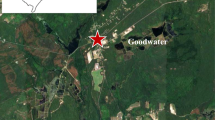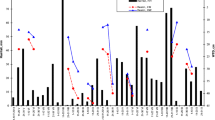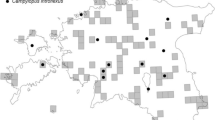Abstract
Many high-elevation wetlands have been degraded by activities related to the skiing industry. However, few studies exist on their restoration in this harsh environment. From 2010 to 2017, we set up an experiment on a degraded bog located at 2500 m within the ski resort of Val-Thorens (France). We tested (1) if transplanting two sedge species, Trichophorum cespitosum and Eriophorum scheuchzeri effectively helped to initiate the restoration of the bog vegetation and (2) if different planting combinations of the species under different mulch treatments affected transplant survival and cover. After stabilising the bare peat with wood fascines and installed weirs in the incised gully that drained the bog, we planted tussocks of T. cespitosum and ramets of E. scheuchzeri, each alone or in mixture. We used straw mulch or a “biomulch” made of live shoots of Polytrichum moss. After a slight increase the first 2 years, the number of E. scheuchzeri ramets decreased continuously in all treatments and reached zero in 2016. T. cespitosum had a low mortality in all treatments; its annual survival rate and cover were significantly higher with biomulch. Because of strong winds and snow action, all the straw was removed after 2 years while the biomulch cover remained between 10 and 25% from the third to the fifth year then was close to zero from 2016. Nevertheless, this low cover seemed sufficient to favour the survival and growth of T. cespitosum. In 2017, bare soil was lower in all treatments with biomulch and T. cespitosum. This treatment appears to be the best restoration option, but it is likely that more than 7 to 10 years will be required to establish adequate plant cover at degraded high-elevation sites.






Similar content being viewed by others
References
Austin G, Cooper DJ (2016) Persistence of high elevation fens in the Southern Rocky Mountains, on Grand Mesa, Colorado, USA. Wetl Ecol Manag 24(3):317–334. https://doi.org/10.1007/s11273-015-9458-7
Barnaud G, Fustec E (2007) Un bilan contrasté, des perscpectives alarmantes. In: Educagri/Quae (ed) Conserver les milieux humides: pourquoi? comment? (Conserving wetlands: why? how?), 1st edn. Educagri/Quae, Dijion, pp 248–282
Berube V, Rochefort L (2018) Production and decomposition rates of different fen species as targets for restoration. Ecol Indic 91:105–115. https://doi.org/10.1016/j.ecolind.2018.03.069
Bragazza L (2006) Chapter 12 Consequences of increasing levels of atmospheric nitrogen deposition on ombrotrophic peatlands: a plant-based perspective. In: Martini AMC, Chesworth W (eds) Developments in Earth Surface Processes. Elsevier, Amsterdam, pp 271–285
Bragg OM, Tallis JH (2001) The sensitivity of peat-covered upland landscapes. CATENA 42(2–4):345–360
Carello C, Woehler A, Grevstad N, Kleier C (2018) Impacts of recreation management practices in a subalpine wetland system dominated by the willow plant, Salix planifolia. Wetl Ecol Manag 26(1):119–124. https://doi.org/10.1007/s11273-017-9552-0
Cooper DJ, Gaucherand S, Kacyzinski K, Borkenhagen A, McKenna G (2014) Lessons from oil Sands and international wetland reclamation and restoration projects: a selective literature review. In: Association RWGCEM (ed) Guideline for wetland establishment on reclaimed oil sands leases. Reclamation Working Group Cumulative Environmental Management Association, Fort McMurray, Alberta, Canada
Cooper DJ, Kaczynski KM, Sueltenfuss J, Gaucherand S, Hazen C (2017) Mountain wetland restoration: the role of hydrologic regime and plant introductions after 15 years in the Colorado Rocky Mountains, USA. Ecol Eng 101:46–59. https://doi.org/10.1016/j.ecoleng.2017.01.017
Daniels SM, Agnew CT, Allott TEH, Evans MG (2008) Water table variability and runoff generation in an eroded peatland, South Pennines, UK. J Hydrol 361(1–2):214–226
David GCL, Bledsoe BP, Merritt DM, Wohl E (2009) The impacts of ski slope development on stream channel morphology in the White River National Forest, Colorado, USA. Geomorphology 103(3):375–388
De Rosario-Martinez H, Fox J, Team RC (2015) phia: post-hoc interaction analysis. 0.2-1 edn
Delgado R, Sanchez-Maranon M, Martin-Garcia JM, Aranda V, Serrano-Bernardo F, Rosua JL (2007) Impact of ski pistes on soil properties: a case study from a mountainous area in the Mediterranean region. Soil Use Manag 23:269–277
Devillers P, Devillers-Terschuren J, Ledant J-P, et al (1991) CORINE biotopes manual. Habitats of the European Community. Data specifications (updated 2015). Part 2. EUR 12587/3 EN. European Commission, Luxembourg
Dinger F (1997) Végétalisation des espaces dégradés en altitude (Vegetalisation of high altitude degraded lands). Cemagref éditions, Grenoble
Duval TP, Waddington JM, Branfireun BA (2010) Towards calcareous wetland creation in flooded abandoned aggregate quarries: a 3-year field mesocosm study. Ecol Eng 36(4):586–595
Fernández-Pascual E (2016) Comparative seed germination traits in bog and fen mire wetlands. Aquat Bota 130:21–26. https://doi.org/10.1016/j.aquabot.2016.01.001
Gagnon F, Rochefort L, Lavoie C (2018) Spontaneous revegetation of a peatland in Manitoba after peat extraction: diversity of plant assemblages and restoration perspectives. Botany 96(11):779–791. https://doi.org/10.1139/cjb-2018-0109
Gómez-Aparicio L (2009) The role of plant interactions in the restoration of degraded ecosystems: a meta-analysis across life-forms and ecosystems. J Ecol 97(6):1202–1214. https://doi.org/10.1111/j.1365-2745.2009.01573.x
Gonzalez E, Rochefort L (2014) Drivers of success in 53 cutover bogs restored by a moss layer transfer technique. Ecol Eng 68:279–290. https://doi.org/10.1016/j.ecoleng.2014.03.051
González E, Rochefort L, Boudreau S, Hugron S, Poulin M (2013) Can indicator species predict restoration outcomes early in the monitoring process? a case study with peatlands. Ecol Indic 32:232–238. https://doi.org/10.1016/j.ecolind.2013.03.019
Goodwillie R (1980) Les tourbières en Europe (Peatlands in Europe). European committee for the protection of nature and natural resources: European Council, Brussels
Goubet P, Thebaut G, Petel G (2004) Les modèles théoriques du dévloppement des haut-maris: un outil pour la gestion conservatoire des tourbières/Theoritical models of peat bog growth: a tool for conservation policies. Geocarrefour 79(4):303–315
GRET (2015) Restauration des tourbières minérotrophes: état des connaissances 2015 (Restoration of fens: state of knowledge 2015. Text in French. Groupe de recherche en écologie des tourbières, Québec, Québec. http://www.gret-perg.ulaval.ca/uploads/tx_centrerecherche/Restaur_tourb_miner_Etat_connaissances_2015.pdf)
Groeneveld EVG, Rochefort L (2005) Polytrichum strictum as a solution to frost heaving in disturbed ecosystems: a case study with milled peatlands. Restor Ecol 13:74–82
Groeneveld EVG, Massé A, Rochefort L (2007) Polytrichum strictum as a nurse-plant in peatland restoration. Restor Ecol 15:709–719
Holden J, Burt TP (2003) Hydrological studies on blanket peat: the significance of the acrotelm-catotelm model. J Ecol 91(1):86–102. https://doi.org/10.1046/j.1365-2745.2003.00748.x
Holden J, Chapman PJ, Labadz JC (2004) Artificial drainage of peatlands: hydrological and hydrochemical process and wetland restoration. Prog Phys Geogr 28:95–123
Holden J, Wallage ZE, Lane SN, McDonald AT (2011) Water table dynamics in undisturbed, drained and restored blanket peat. J Hydrol 402(1):103–114. https://doi.org/10.1016/j.jhydrol.2011.03.010
Isselin-Nondedeu F, Bédécarrats A (2007) Soil microtopographies shaped by plants and cattle facilitate seed bank formation on alpine ski trails. Ecol Eng 30(3):278–285
Isselin-Nondedeu F, Spiegelberger T (2014) Alpine grasslands: changes of plant species composition and functional types after restoration and simulation of climate changes. In: Pierre Mariotte PK (ed) Grassland biodiversity and conservation in a changing world. Environmental science, engineering and technology series. Nova Science Publishers Inc, New York, pp 219–250
Isselin-Nondedeu F, Rey F, Bédécarrats A (2006) Contributions of vegetation cover and cattle hoof prints towards seed runoff control on ski pistes. Ecol Eng 27(3):193–201
Kay M, Wobbrock J (2016) ARTool: Aligned rank transform for nonparametric factorial ANOVAs. 2
Krautzer B, Whittman H (2012) Restoration of arctic-alpine ecosystems. In: Van Andel J, Aronson J (eds) Restoration ecology, the new frontier, vol 15, 2nd edn. Blackwell publishing Ltd., Chichester, pp 189–202
Lavoie C, Grosvernier P, Girard M, Marcoux K (2003) Spontaneous revegetation of mined peatlands: an useful restoration tool? Wetl Ecol Manag 11:97–107. https://doi.org/10.1023/A:1022069808489
Lenth R, Singmann H, Love J, Buerkner P, Herve M (2019) emmeans: estimated marginal means. 1.3.5.1 edn
Manneville O (2001) La diversité des tourbières en France et leur prise en compte dans les politiques de conservation (The diversity of peatlands in France and their integration in conservation policies). Paper presented at the Outils pour la conservation de la biodiversité dans les domaines némoral et boréonémoral européens, Sweden
Manneville O (2007) Diversité et particularités des tourbières des Alpes duphinoises et savoyardes (Diversity and peculiarities of peatlands in the north Alps). Paper presented at the Premières rencontres pour la conservation des tourbières, Chamrousse, France
Parry LE, Holden J, Chapman PJ (2014) Restoration of blanket peatlands. J Environ Manag 133:193–205. https://doi.org/10.1016/j.jenvman.2013.11.033
Poulin M, Rochefort L, Quinty F, Lavoie C (2005) Spontaneous revegetation of mined peatlands in eastern Canada. Can J Bot 83:539–557
Price JS, Heathwaite AL, Baird AJ (2003) Hydrological processes in abandoned and restored peatlands: an overview of management approaches. Wetl Ecol Manag 11:65–83
Quinty F, Rochefort L (2003) Peatland restoration guide, 2nd edn. Québec, Québec
Ramchunder SJ, Brown LE (2009) Holden J (2009) Environmental effects of drainage, drain-blocking and prescribed vegetation burning in UK upland peatlands. Progress Phys Geogr 33:49–79
Rixen C, Stoeckli V, Ammann W (2003) Does artificial snow production affect soil and vegetation of ski pistes? A review. Perspect Plant Ecol Evol Syst 5(4):219–230
Robert EC, Rochefort L, Garneau M (1999) Natural revegetation of two block-cut mined peatlands in eastern Canada. Can J Bot 77:447–459
Rochefort L, Quinty F, Campeau S, Johnson K, Malterer T (2003) North American approach to the restoration of Sphagnum dominated peatlands. Wetl Ecol Manag 11:109–119
Rochefort L, Isselin-Nondedeu F, Boudreau S, Poulin M (2013) Comparing survey methods for monitoring vegetation change through time in a restored peatland. Wetl Ecol Manag 21(1):71–85. https://doi.org/10.1007/s11273-012-9280-4
Schimelpfenig D, Cooper DJ, Chimner R (2014) Effectiveness of ditch blockage for restoring hydrologic and soil processes in mountain peatlands. Restor Ecol 22:257–265
Schoeneich P, de Jong C (2009) Changes in the Alpine environment. How will the Alpine environment be tomorrow? J Alp Res 96(4):65–76
Shantz MA, Price JS (2006) Hydrological changes following restoration of the Bois-des-Bel Peatland, Quebec, 1999–2002. J Hydrol 331(3–4):543–553
Tasser E, Tappeiner U (2002) Impact of land use changes on mountain vegetation. App Veg Sci 5:173–184
Tasser E, Mader M, Tappeiner U (2003) Effects of land use in alpine grasslands on the probability of landslides. Basic App Ecol 4:271–280
Urbanska KM (1997) Restoration ecology research above the timberline: colonization of safety islands on a machine-graded alpine ski run. Biodivers Conserv 6:1655–1670
van Dijk J, Stroetenga M, van Bodegom PM, Aerts R (2007) The contribution of rewetting to vegetation restoration of degraded peat meadows. App Veg Sci 10:315–324
Waddington JM, Price JS (2000) Effect of peatland drainage, harvesting, and restoration on atmospheric water and carbon exchange. Phys Geogr 21(5):433–451
Warburton J (2003) Wind-splash erosion of bare peat on UK upland moorlands. CATENA 52(3–4):191–207
Wilson L, Wilson J, Holden J, Johnstone I, Armstrong A, Morris M (2010) Recovery of water tables in Welsh blanket bog after drain blocking: discharge rates, time scales and the influence of local conditions. J Hydrol 391(3):377–386. https://doi.org/10.1016/j.jhydrol.2010.07.042
Wind-Mulder HL, Rochefort L, Vitt DH (1996) Water and peat chemistry comparisons of natural and post-harvested peatlands across Canada and their relevance to peatland restoration. Ecol Eng 7(3):161–181
Wipf S, Rixen C, Fischer M, Schmid B, Stoeckli V (2005) Effects of ski piste preparation on alpine vegetation. J Appl Ecol 42:306–316
Acknowledgements
We are very grateful to the staff of the SETAM from Val Thorens, and particularly to Jean-François Piard and Carmen Jay. We thank Stéphanie David, Hugo Cogez, Lucile Bidet, Boris Varry, Léonard Benchimol for their help on the field. We also thank David Cooper who helped for proofreading, as for professional from ProofReadingService. We also thank the two anonymous reviewers and the subject editor who greatly helped to improve the manuscript.
Funding
This study was partly supported by the ski resort of Val Thorens.
Author information
Authors and Affiliations
Corresponding author
Additional information
Publisher's Note
Springer Nature remains neutral with regard to jurisdictional claims in published maps and institutional affiliations.
Electronic supplementary material
Below is the link to the electronic supplementary material.
Rights and permissions
About this article
Cite this article
Isselin-Nondedeu, F., Gaucherand, S. Transplanting success of two alpine plant species in combination with mulching during restoration of a high-elevation peatland. Wetlands Ecol Manage 28, 71–84 (2020). https://doi.org/10.1007/s11273-019-09695-y
Received:
Accepted:
Published:
Issue Date:
DOI: https://doi.org/10.1007/s11273-019-09695-y




